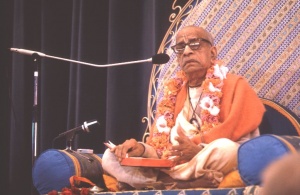SB 4.25.2: Difference between revisions
m (1 revision(s)) |
(Vanibot #0054 edit - transform synonyms into clickable links, which search similar occurrences) |
||
| (One intermediate revision by one other user not shown) | |||
| Line 1: | Line 1: | ||
{{info | {{info | ||
|speaker= | |speaker=Maitreya Ṛṣi | ||
|listener=King | |listener=Vidura | ||
}} | }}[[Category:Srimad-Bhagavatam - Canto 04 Chapter 25|s02 ]] | ||
[[Category:Bhagavatam Verses Spoken by Maitreya Rsi - Vanisource|042502]] | |||
<div style="float:left">'''[[Srimad-Bhagavatam]] - [[SB 4|Fourth Canto]] - [[SB 4.25: The Descriptions of the Characteristics of King Puranjana|Chapter 25: The Descriptions of the Characteristics of King Purañjana]]'''</div> | |||
<div style="float:right">[[File:Go-previous.png|link=SB 4.25.1]] '''[[SB 4.25.1]] - [[SB 4.25.3]]''' [[File:Go-next.png|link=SB 4.25.3]]</div> | |||
{{RandomImage}} | |||
==== TEXT 2 ==== | ==== TEXT 2 ==== | ||
<div | <div class="verse"> | ||
rudra-gītaṁ bhagavataḥ | :rudra-gītaṁ bhagavataḥ | ||
stotraṁ sarve pracetasaḥ | :stotraṁ sarve pracetasaḥ | ||
japantas te tapas tepur | :japantas te tapas tepur | ||
varṣāṇām ayutaṁ jale | :varṣāṇām ayutaṁ jale | ||
</div> | </div> | ||
| Line 16: | Line 23: | ||
==== SYNONYMS ==== | ==== SYNONYMS ==== | ||
<div | <div class="synonyms"> | ||
rudra- | ''[//vanipedia.org/wiki/Special:VaniSearch?s=rudra&tab=syno_o&ds=1 rudra]-[//vanipedia.org/wiki/Special:VaniSearch?s=gītam&tab=syno_o&ds=1 gītam]'' — the song sung by Lord Śiva; ''[//vanipedia.org/wiki/Special:VaniSearch?s=bhagavataḥ&tab=syno_o&ds=1 bhagavataḥ]'' — of the Lord; ''[//vanipedia.org/wiki/Special:VaniSearch?s=stotram&tab=syno_o&ds=1 stotram]'' — prayer; ''[//vanipedia.org/wiki/Special:VaniSearch?s=sarve&tab=syno_o&ds=1 sarve]'' — all; ''[//vanipedia.org/wiki/Special:VaniSearch?s=pracetasaḥ&tab=syno_o&ds=1 pracetasaḥ]'' — the princes known as the Pracetās; ''[//vanipedia.org/wiki/Special:VaniSearch?s=japantaḥ&tab=syno_o&ds=1 japantaḥ]'' — reciting; ''[//vanipedia.org/wiki/Special:VaniSearch?s=te&tab=syno_o&ds=1 te]'' — all of them; ''[//vanipedia.org/wiki/Special:VaniSearch?s=tapaḥ&tab=syno_o&ds=1 tapaḥ]'' — austerity; ''[//vanipedia.org/wiki/Special:VaniSearch?s=tepuḥ&tab=syno_o&ds=1 tepuḥ]'' — executed; ''[//vanipedia.org/wiki/Special:VaniSearch?s=varṣāṇām&tab=syno_o&ds=1 varṣāṇām]'' — of years; ''[//vanipedia.org/wiki/Special:VaniSearch?s=ayutam&tab=syno_o&ds=1 ayutam]'' — ten thousand; ''[//vanipedia.org/wiki/Special:VaniSearch?s=jale&tab=syno_o&ds=1 jale]'' — within the water. | ||
</div> | </div> | ||
| Line 23: | Line 30: | ||
==== TRANSLATION ==== | ==== TRANSLATION ==== | ||
<div | <div class="translation"> | ||
All the Pracetā princes simply stood in the water for ten thousand years and recited the prayers given to them by Lord Śiva. | All the Pracetā princes simply stood in the water for ten thousand years and recited the prayers given to them by Lord Śiva. | ||
</div> | </div> | ||
| Line 30: | Line 37: | ||
==== PURPORT ==== | ==== PURPORT ==== | ||
<div | <div class="purport"> | ||
Of course in the modern age one may be amazed how the princes could stand in the water for ten thousand years. However, living within air or living within water is the same process; one simply has to learn how to do it. The aquatics live within water for their whole life-span. Certain favorable conditions are created to enable them to live within water. In those days, however, people used to live for one hundred thousand years. Out of so many years, if one could spare ten thousand years for the sake of austerity, he would be assured of success in his future life. This was not very astonishing. Although such a feat is impossible in this age, it was quite possible in Satya-yuga. | Of course in the modern age one may be amazed how the princes could stand in the water for ten thousand years. However, living within air or living within water is the same process; one simply has to learn how to do it. The aquatics live within water for their whole life-span. Certain favorable conditions are created to enable them to live within water. In those days, however, people used to live for one hundred thousand years. Out of so many years, if one could spare ten thousand years for the sake of austerity, he would be assured of success in his future life. This was not very astonishing. Although such a feat is impossible in this age, it was quite possible in Satya-yuga. | ||
</div> | </div> | ||
__NOTOC__ | |||
<div style="float:right; clear:both;">[[File:Go-previous.png|link=SB 4.25.1]] '''[[SB 4.25.1]] - [[SB 4.25.3]]''' [[File:Go-next.png|link=SB 4.25.3]]</div> | |||
__NOTOC__ | |||
__NOEDITSECTION__ | |||
Latest revision as of 21:40, 18 February 2024

A.C. Bhaktivedanta Swami Prabhupada
TEXT 2
- rudra-gītaṁ bhagavataḥ
- stotraṁ sarve pracetasaḥ
- japantas te tapas tepur
- varṣāṇām ayutaṁ jale
SYNONYMS
rudra-gītam — the song sung by Lord Śiva; bhagavataḥ — of the Lord; stotram — prayer; sarve — all; pracetasaḥ — the princes known as the Pracetās; japantaḥ — reciting; te — all of them; tapaḥ — austerity; tepuḥ — executed; varṣāṇām — of years; ayutam — ten thousand; jale — within the water.
TRANSLATION
All the Pracetā princes simply stood in the water for ten thousand years and recited the prayers given to them by Lord Śiva.
PURPORT
Of course in the modern age one may be amazed how the princes could stand in the water for ten thousand years. However, living within air or living within water is the same process; one simply has to learn how to do it. The aquatics live within water for their whole life-span. Certain favorable conditions are created to enable them to live within water. In those days, however, people used to live for one hundred thousand years. Out of so many years, if one could spare ten thousand years for the sake of austerity, he would be assured of success in his future life. This was not very astonishing. Although such a feat is impossible in this age, it was quite possible in Satya-yuga.